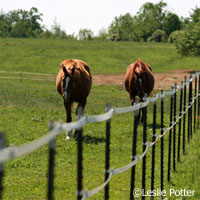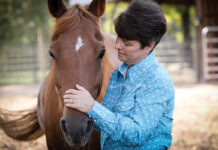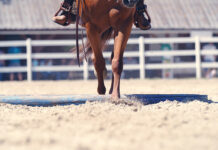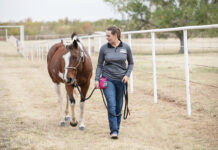 Where your horses are concerned, it’s better to be safe than sorry. The very qualities that attract us to horses—size and strength, intelligence, playfulness, curiosity—are what necessitate a secure turnout environment. So, without fail, regular checks of your pasture and surrounding fence should be integrated into your barn chores. After all, most pasture hazards are like weeds—you can get rid of them, but that doesn’t mean they won’t come back. Here are the top 10:
Where your horses are concerned, it’s better to be safe than sorry. The very qualities that attract us to horses—size and strength, intelligence, playfulness, curiosity—are what necessitate a secure turnout environment. So, without fail, regular checks of your pasture and surrounding fence should be integrated into your barn chores. After all, most pasture hazards are like weeds—you can get rid of them, but that doesn’t mean they won’t come back. Here are the top 10:
1. Gates Left Open
2. Electric Fence Failure
All horse fencing should be inspected periodically; however, electric fence requires extra attention. It is a sound and inexpensive alternative to wood, PVC and non-electrified high tensile, but it easily shorts out and loses voltage. Any number of occurrences can cause an electric fence failure: fallen tree limbs, rusty wire connections that either sap the voltage or break, wet grass and weeds, or broken insulators that allow wire to come into contact with fence.
A continuous snapping noise often alerts you to a problem with your electric fence, yet voltage drainage can be silent and go undetected for quite a while if you fail to check your system. You can buy inexpensive, hand-held voltage testers for manual checks, or make this as easy as a glance with a voltage tester that permanently hangs on your electric fence.
3. Loose or Broken Boards
Many horse owners choose to install board fence rather than lower-maintenance options because of wood’s beauty, sturdiness and long history of association with fine horse farms. Unfortunately, weather wreaks havoc on wood, causing dryness and splitting, leading to popped nails and loose boards. Even without the damaging effects of weather, horses love to chew, lean on, scratch their butts against, stick their heads through and push each other into fencing, all of which results in weakened boards. Broken wood is the cause of most fence-related puncture wound injuries. Paint the wood fence to protect it from the drying effects of weather and anchor the nails to posts. Periodically walk your fence line to assess damage; carry a hammer and a few nails to avoid a trip back to the barn because invariably the section that needs repair will be in the farthest corner of your field.
4. Protrusions—Tree Limbs, Sharp Edges
Own horses long enough and you will someday be scratching your head about an injury to one of them that just seems impossible. It is a horse truism—if there’s something in the pasture your horses should stay away from, they will find that spot like a heat-seeking missile. One summer evening, my Appaloosa gelding calmly sauntered into the barn with a bloody 2-inch square flap of skin hanging over his eye. An after-hours vet call, four tranquilizers, 24 stitches and $250 later, I never did find out how he sliced open his forehead. Even so, that injury became the catalyst to reinspect and “horseproof” my pastures.
5. Toxic Plants
The easiest way to find out what toxic plants you should be looking for in your pasture is to contact your agricultural extension agent and ask about which ones thrive in your region. You can then either search the Internet to identify those plants (there are scads of websites devoted to this subject), or buy a book such as the Horse Owners Field Guide to Toxic Plants by Sandra Burger (Breakthrough, 1996).
Toxic plants and deadly pasture inhabitants are like serial killers—they often appear harmless. Investigators were stumped a few years ago when an inordinate number of Kentucky foals died mysteriously. Turns out, the culprits were tent caterpillars that eliminated a form of cyanide after eating cherry tree leaves. Other “killer bugs” are blister beetles that infest hay. And, pregnant mare owners should be aware of fescue toxicosis that causes the placenta to separate prematurely.
| Louann Chaudier is a freelance writer and horse owner based in Wisconsin. |
6. Objects Working Up from the Ground
Before I owned a farm, I never understood why farmers have to “pick rock” more than once. I was incredulous that items in the ground could rise to the surface without anyone digging for them. Well, now I know. It isn’t so much that items work their way up, as the elements, and our horses, work the soil down. If there’s something sharp, it may very well end up under your horse’s hoof. Unfortunately, our horses’ eyes are far away from their feet, and when they are busy running and playing, they aren’t particularly careful about where they put those hooves. Again, check your pasture periodically for anything potentially dangerous underfoot.
7. Wrong Kind of Fence
In order for your horses to be safe in their pasture, the fence needs to accommodate the specific types of horses you own. If you own a stallion, for example, he should not be pastured near a field of mares without a sturdy fence that’s tall enough to discourage him from jumping or running through it. Aside from the considerable hazards of your stallion running loose, none of your neighbors will welcome an unplanned foal either.
Mares with foals require special consideration, too. If the bottom rail of your fence is high enough for a foal to roll under, one day you may find him outside the pasture while his frantic mother paces and calls from the other side. This is another disaster in the making. You thought enough of your mare to want a foal from her, so why tempt fate? Pasture the mare and foal within a fence designed to keep them safely together such as “horseproof” no-climb wire mesh.
If you buy a farm that has unsuitable fence for horses, you must replace it. The money you spend for one vet bill caused by a horrific injury will go a long way toward paying for safe fencing. If you are new to horse-farm ownership and not sure what’s best for your particular circumstances, contact major fence manufacturers or dealers, or do your own research via magazine articles, books and the Internet. Fence manufacturers will be glad to provide information to help you make an informed choice based upon your type of operation and budget.
8. Incompatible Horses Pastured Together
Horses are similar to people in that they sometimes just don’t like their close neighbors, but unlike us they can’t simply avoid them. The conflicts created by equine personality clashes can be quite severe, so it’s never advisable to introduce a new horse to your herd by opening the pasture gate and assuming they will “sort it out.” In fact, you should initiate a gradual process to get them acquainted whereby they can’t hurt each other.
Horses can be brutal, like schoolchildren. Some will never accept a particular individual, and, if allowed, may run the poor horse ragged or right through a fence. You need to be aware that these skirmishes can crop up any time there’s a new member in the pasture whose place has yet to be established in the herd.
Age can cause a change in compatibility, too. Herd hierarchy often changes when illness or age affect a horse’s ability to maintain his position. Inevitably, there will be a horse that wants to take his place.
9. Shared Fence Lines
Even though most of us want to use every spare foot of land for pasture, it’s not advisable to share fence lines between pastures of horses that are likely to play or fight over the top. This is a judgment call: If you have adjoining pastures of geriatrics, you probably don’t need to worry; however, if you have yearling colts on one side and 2-year-olds on the other, you’d be better off with an aisle between fields. Stallions shouldn’t be able to interact over the fence, either.
Even with adjoining fields of compatible horses, it’s wise to adopt injury-preventive measures such as putting caps on t-posts, stringing electric wire or tape along the top rail, or “flagging” fence to define boundaries for new horses.
10. Gopher/Animal Holes
Many old westerns feature cowboys atop galloping horses that take spectacular tumbles after inadvertently stepping into an animal burrow. That may seem an unlikely occurrence for more urban settings; however, if you look closely, animal burrows are everywhere. On my own Wisconsin farm I have a surplus of gophers, groundhogs and chipmunks that think my pasture makes a great subdivision. Some of the holes are too small for a hoof; others are big enough to accommodate an NFL football. Holes in the pasture should be identified and filled in each spring, before they become invisible by summer grass and weeds. Similarly, if you’ve picked rock out of your pasture and left sizeable hollows in the ground, these should be filled. Check for old post-holes as well.
Eliminating pasture hazards is essential to the well-being of our horses and, for those of us who ride in our pastures, our own personal safety. The time we spend checking our pastures and fences is minimal compared to the hours we’d incur nursing an injured horse.
Read more on pasture management >>
* This article first appeared in the March 2005 issue of Horse Illustrated.
Subscribe today!






Great article. It really makes you look at your own pastures. You may even realize what you need to do to fix problems
very good!
Thanks! Great article.
great article
Superb!
goood article … nice info … i definitly learned from it !
Great tips!
Great basic information – I’m in a boarding situation and I need to convince the owners
this is important!
iam a fence contractor , when it comes to fencing so many people are in the dark ages , thier are many styles of fence to choose from today , that are safer look nice as well . an take less time to maintain, I understand they may cost more to put in the long they will save you money .